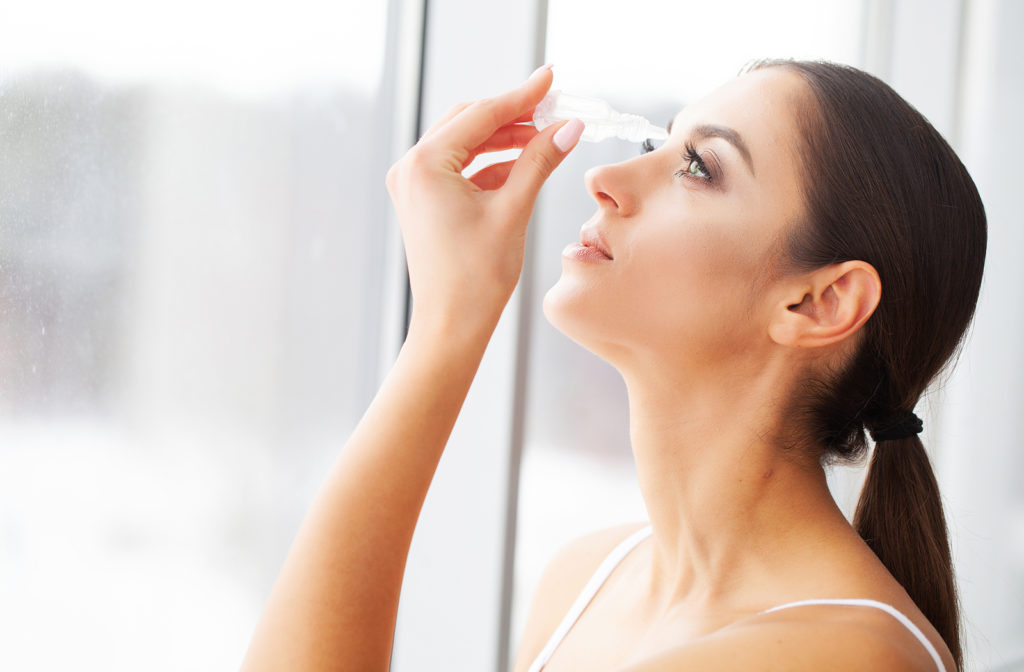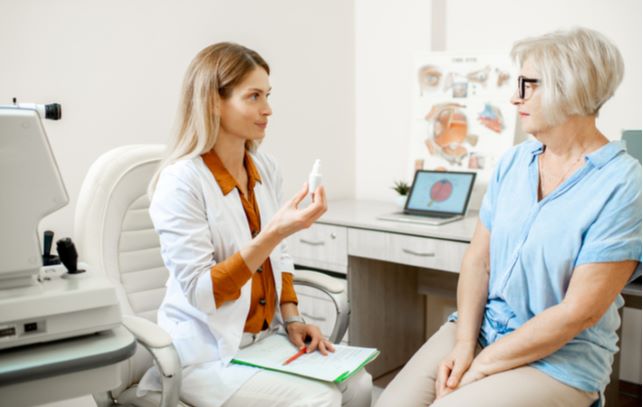Are you experiencing red, dry, or uncomfortable eyes? It could be a sign that you have dry eye disease. Luckily, your optometrist can help you find relief from your dry eye symptoms with dry eye therapy.
But how do you know when it’s time to see your optometrist? Keep reading to learn more about dry eye disease, how to know when you should book an appointment with your eye doctor, and what type of treatments are available to you.
What is Dry Eye Disease?
Dry eye disease is a common eye condition that can cause a variety of symptoms.
But what exactly is dry eye disease? To understand how dry eye disease works, we first need to understand how tears work.
Your tears have three layers: an oily layer, a watery layer, and a mucous layer. In order for your tears to keep your eyes moist and seeing well like they’re meant to, they need to have an adequate amount of each of these layers.
If your tears lack any one of these layers it can lead to two types of dry eye disease:
- Evaporative dry eye occurs when there isn’t enough of the oily layer in your tears, causing your tears to evaporate too quickly.
- Aqueous tear deficient dry eye occurs when your tears lack the aqueous layer needed to keep the eye moist.
What are the Symptoms of Dry Eye Disease?
Dry eye disease can result in a number of different symptoms, including:
- Redness
- Stinging, scratching, or a burning sensation
- Sensitivity to light
- Feeling like something is stuck in your eye
- Watery eyes
- Stringy mucus near the eye
- Blurred vision
- Difficulty wearing contacts
6 Signs You Should Seek Help for Your Dry Eye
If you think you may have dry eye disease, it’s best to see your optometrist so they can help you find the treatment that’s right for you and your symptoms. But how do you know when it’s time to see your eye doctor?
If you’re experiencing any of the following, it’s best to book an appointment with your optometrist to get professional help:
- Your symptoms aren’t going away
- Your symptoms are getting worse with time
- You develop other symptoms you didn’t have before
- You’re not sure what’s causing your dry eye
- At-home treatment doesn’t help or has stopped working
- You’re experiencing emotional distress from your symptoms
Where to Get Help
If you think you have dry eye disease, your optometrist can help!
Many optometrists are specifically trained in diagnosing and treating dry eye disease. To make sure you’re getting the best treatment possible, look for eye care practices that specialize in dry eye therapy.
During your appointment, your optometrist will perform a comprehensive dry eye evaluation to find out what’s causing your dry eye. Once they know what’s causing your dry eye, they can recommend a treatment plan suited to your individual needs.
Types of Dry Eye Treatment
At LaFerla Family Eyecare , our optometrists are knowledgeable on the topic of dry eye disease and we are constantly updating our dry eye therapies so we can help every patient that walks through our doors.
Our dry eye therapies include:
Artificial Tears
Artificial tears are eye drops designed to hydrate your eyes. While artificial tears aren’t a long-term solution, they provide quick relief for the irritating dry eye symptoms you may be experiencing.

Medicated Eye Drops
Medicated eye drops are prescription eye drops used to reduce inflammation in patients with chronic dry eyes. Your optometrist can recommend the right type of medicated eye drop for you, depending on the cause of your dry eye and your symptoms.
Lumenis Intense Pulsed Light (IPL) Therapy
Lumenis IPL therapy is the only FDA-approved light-based procedure that works by promoting proper function and health of the Meibomian glands, and preventing Meibomian gland death. The result of IPL therapy is healthier Meibomian glands, healthier tear film, and more patient comfort.
Alcon iLux Therapy
Alcon iLux therapy gives patients with moderate dry eye symptoms relief by heating and compressing the Meibomian glands in the eyelids. Eyelid compressions unblock the meibomian glands and allow the oil to start flowing to the tear film, helping the watery layer in the tears to evaporate less quickly. This creates a healthier tear film layer, which can increase patient comfort.
Dry Eye Relief Masks
If you have a mild case of dry eye disease, dry eye relief masks may be able to help reduce your symptoms. Dry eye relief masks are moist-heat compresses and can help you find relief from symptoms after being placed over the eye for short periods.
Punctal Plugs
If your dry eye disease is caused by irregular tear drainage, punctal plugs may be the solution for you. Punctal plugs are placed in the tiny ducts, or the puncta, in your eyes. If your tears are draining too quickly for your eyes, punctal plugs can help you keep a sufficient layer of tears on your eyes.
Find Relief From Dry Eye Disease
Proper diagnosis and treatment can help you find relief from dry eye symptoms. At LaFerla Family Eyecare, one of our Optometrists in Kansas City can help you find the cause of your dry eyes and get you started on a customized dry eye care plan.
Don’t let dry eyes affect your life any longer! Book an appointment with us today to get the help you need.



